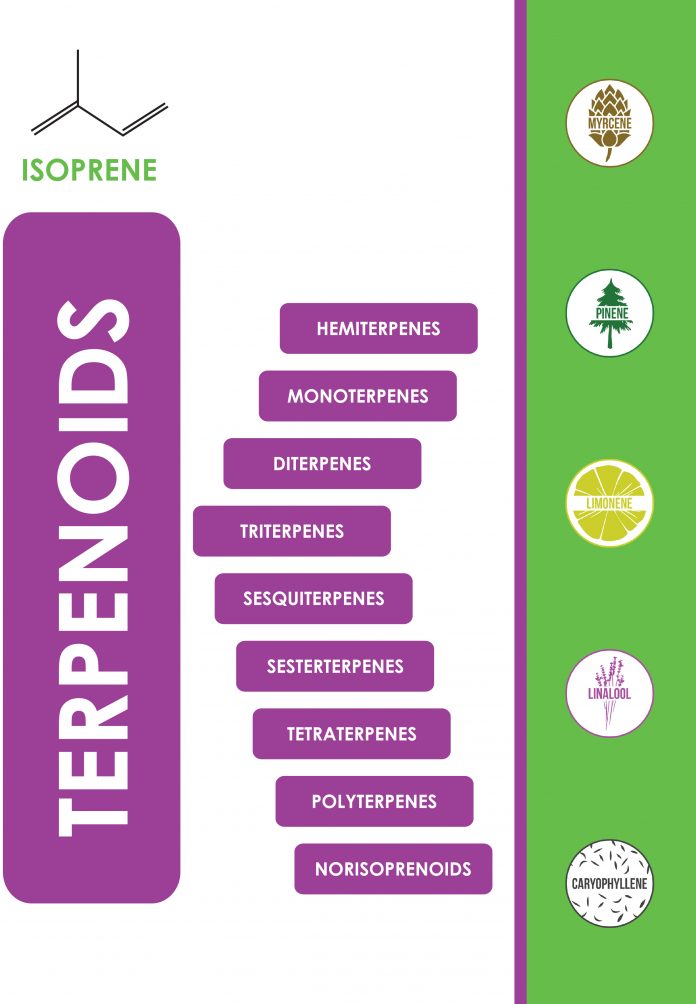By Jake Towner
Google dictionary defines terpenes as the following; “any of a large group of volatile unsaturated hydrocarbons found in the essential oils of plants, especially conifers and citrus trees. They are based on a cyclic molecule having the formula C10H16.” This means very little to you even if you are a chemist and leaves one desiring more details about what terpenes are and what they do. I will attempt to begin a systematic approach of detailing some terpenes that exist, more specifically the common terpenes in cannabis, and describe their effects to you. I will also investigate whether the affect a terpene has’ changes if the source of the terpene is different. For example, is limonene from lemons the same as limonene from Lemon Hindu Kush cannabis? More importantly is limonene from organic sources superior to synthetic limonene sourced from petroleum?
There is a systematic approach to naming terpenes which organizes the massive variety of terpenes that exist. First however, we will define terpenes another way. Terpenes are the molecules that are created from the reaction of two or more isoprene units. Isoprene is 2-methyl-1, 3-butadiene and is a common organic compound with the formula CH2=C(CH3)−CH=CH2. In experience Isoprene is one of the main components of the emissions that come from planetary flora. When you’re walking through a forest, the smell that you’re smelling is a mixture of isoprene, terpenes and other organic molecules. The importance is that isoprene’s are evolutionary adapted to be good for human health. Anyone can acclaim the rejuvenating effects of nature, which could be partially attributed to the activity that isoprene and terpenes have on the human body. Breathing in isoprene and terpenes gets you ‘high.’ It’s not just in your head or psychological. When breathing forest air rich in these molecules someone is going to feel better than when they would breathing in fossil fuel exhausts like when in the depths of a city.
The systematic approach of naming and defining terpenes is based on the number of isoprene units that exist in the terpene. They are as follows; hemiterpenes, monoterpenes, diterpenes, triterpenes, sesquiterpenes, sesterterpenes, sesquarterpenes, tetraterpenes, polyterpenes, and norisoprenoids. A little knowledge about prefixes will allow you to understand the basic structures of these groupings of terpenes. Just don’t be confused because mono means one, but a monoterpene contains two isoprene subunits which can be a little confusing. Sesqui- means one and a half, sester- means two and half and so on. The prefix is referring to the number of terpene subunits not the number of isoprene subunits. Hemi means half which means a hemiterpene is just isoprene and in fact isoprene is the only hemiterpene. There are other hemiterpenoids though and we will discuss the difference between terpenoids and terpenes soon. Di- means two so a diterpene has two terpene subunits but four isoprene subunits. This is important because it tells you how large of a molecule you are talking about. This is something to consider when you’re analyzing chemical volatility and important when you’re thinking about vaporizing it. The other consideration is the functional groups attached to the molecule. That brings us to the difference between terpenes and terpenoids. Terpenoids have additional or substituted functional groups attached to the isoprene subunits. These functional groups can have effects on the physical properties of the molecule as well as receptor bonding affinity.
Now that we have a systematic way of talking about terpenes I will give some examples of different terpenes and explain some of the reasons that these terpenes have the properties that they have.
Limonene is a monoterpene as well so it’s next in the systematic order of terpenes we want to talk about since we already talked about isoprene. Limonene has two enantiomers which are the D and L forms of limonene. The D form smells of citrus and the L form is reminiscent of pine-sol. Limonene has specific properties in medicine, for example, its used to promote weight loss, prevent cancer, treat cancer and treat bronchitis. It also has bactericidal properties which work by effecting bacteria’s resistance to changes in temperature and PH. Limonene also works through suppression of a g-protein p21ras. Interference with this growth promoting g-protein suppresses tumor formation. Trail studies have shown that Limonene reduces heart rate, blood pressure, and blood sugar levels in rats which explain how it can be used as a weight loss aid. Lastly limonene has been shown to increase the levels of antioxidant activities which is the reason for its anti-inflammatory effects.
A question that you may have is whether terpenes derived from cannabis are the same as terpenes from other or artificial sources. The simple answer is that no there is no difference between limonene from cannabis, an orange or lemon, or limonene synthesized in a laboratory. However, a better answer is that there is a difference in the activity of limonene’s compared across sources. This is because of the mechanism through which these compounds work and the synergistic effect that occurs when terpenes are consumed in mixtures with other compounds. I would not recommend huffing lemon pledge to lose weight and prevent cancer just because it is full of limonene. Limonene works best when you derive it from a natural source because it comes with the synergistic compliments in the package already – so smoke a bowl and eat a fresh lemon if you need that uplifting type of energy.
Check out the next issue of Kurple where I will discuss details of more specific terpenes, like humulene and pinene, and how they go about doing what they do in the body. In the next issue of Kurple I will also go into some of the other uses for these specific terpenes and terpenoids.


















